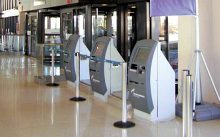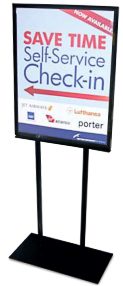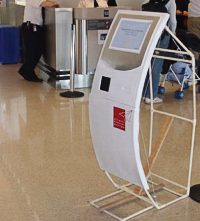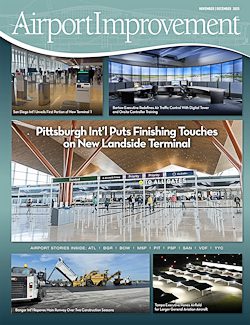 |
The Port Authority footed the $200,000 bill for six trial kiosks with connections to the ticketing systems of four international airlines that fly out of Terminal B. In return, the airlines agreed to pay for the maintenance and upkeep of the common-use kiosks.
For passengers, check-in no longer necessarily means waiting in line at a counter. Instead, they can check in, change seats and print boarding passes at any of the six self-serve kiosks.
 |
The airport likes the kiosks because they give passengers more time to spend inside the terminal dining, drinking and shopping, instead of waiting in line at a ticket counter.
“It’s like a three-legged stool,” Fulford says. “Everybody benefits.”
And the six kiosks are just a start. The initial trial group is being used to study passenger flow through the international ticketing area in Terminal B to prepare for the renovation and expansion of the area, reports Ron Hiscox of Airport Process Design, which is studying the issue for the Port Authority of New York & New Jersey.
 |
Terminal B is in the process of a massive $325 million program that will modernize and reshuffle its space. Domestic arrivals will be moved from the second floor to the first, space previously unused by passengers. The domestic ticketing area will then move from the third floor to the second floor, allowing international ticketing to expand on the third floor.
|
Facts & Figures Project: Common-use Self-serve Check-in Kiosks Location: Newark (NJ) Liberty International Airport, Terminal B Operator: Port Authority of New York & New Jersey Consultant: Airport Process Design Manufacturer: SITA Airport Solutions Initial Size: 6 Kiosks Estimated Cost: $200,000 Benefits: Customer convenience; passenger flow analysis for future terminal modernization efforts; access to equipment for airlines without enough daily flights to justify dedicated equipment |
The three airlines — SAS, Virgin and Lufthansa — that are part of the test program have been bullish on the results, he reports. The rousing success of trial will likely prompt the installation of more than a dozen additional kiosks once the newly reconfigured international ticketing area is completed. The scalable nature of the system is attractive to the airport for the relatively small floor footprint. More kiosks can easily be added as demand from passengers or airlines grows.
Sharing Equipment
The common-use kiosks in Newark’s Terminal B are a bit different from airline-specific units passengers might be used to using in other areas of the airport. According to SITA vice president Catherine Mayer, airlines and airports throughout the industry are considering common-use kiosks, largely for their cost-sharing advantages.
Within the next five years, common-use kiosks will be used for 63% of check-in actions at airports that offer such kiosks, up from roughly 18% now, Mayer reports. Common-use kiosks, she explains, offer airports more oversight of the systems and flexibility in their placement while saving airlines the cost of installing and maintaining their own dedicated systems.
At Newark Liberty, common-use kiosks are affecting the new design of the international ticketing area. Eventually, says Hiscox, the kiosks will be the primary path of passenger check-in and the role of the check-in desk will change. Instead of being seen as a fixture in the ticketing area, it can instead be viewed as a piece of furniture that isn’t locked into one spot and one size, he explains.
A common-use system can also lead to increased communication between airlines and airport management, leading to the development of common processes for issues such as staffing, baggage acceptance and training, says Hiscox. It can also increase the technical reliability and flexibility of ticketing systems, he adds.
More Uses
The future of self-serve kiosks at Newark and throughout the industry is bright on many fronts.
“Technology is not the limiting factor,” Mayer stresses. Common-use kiosks could also be used to process complaints about luggage and to tag bags for check-in, if federal regulations change, she explains.
There are currently about 20 international carriers operating into and out of Terminal B at Newark. Notables include British Airways, El Al, Jet Airways, Lufthansa German Airlines, Porter, SAS, TAP Air Portugal and Virgin Atlantic. During 2008, the international facility handled more than 27,000 operations and more than 4 million total passengers, a 20% annul increase.


